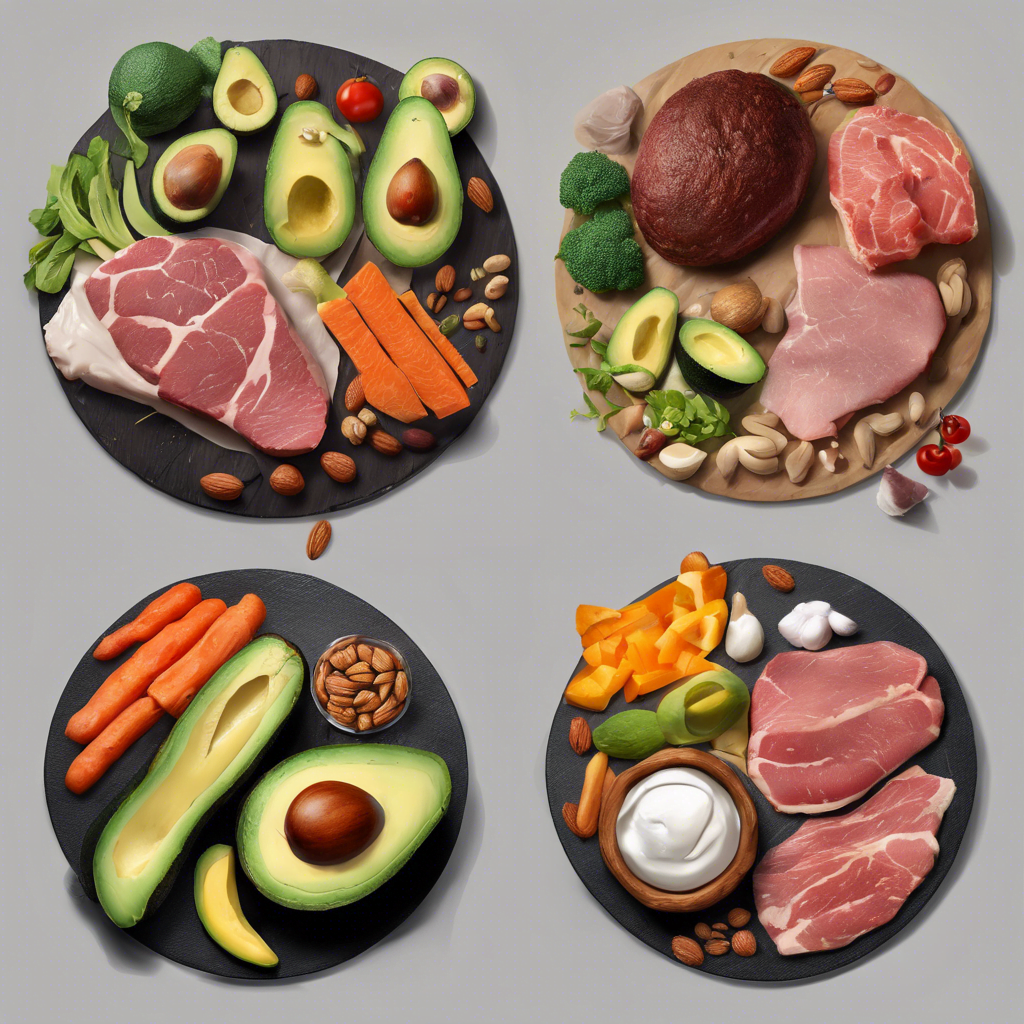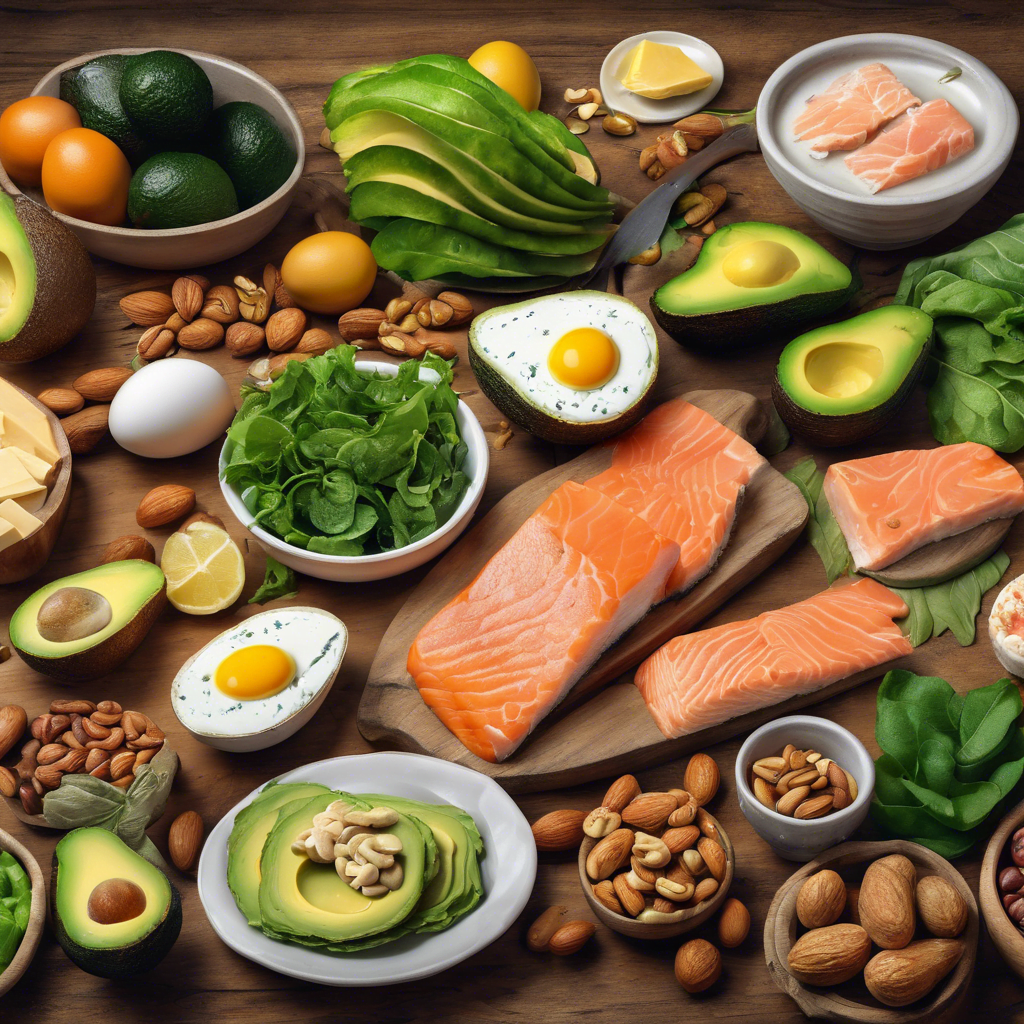Table of Contents
what is difference between keto and carnivore diet
What is the difference between a keto and carnivore diet? A keto diet is a low-carb, high-fat diet that includes both animal and plant foods, while a carnivore diet is a more restrictive diet that includes only animal products.

Both the ketogenic (keto) diet and the carnivore diet are low-crab diets, but they differ in terms of the type of food, the basic principles, and the overall nutritional approach. Here is a detailed comparison: Read More about what is difference between keto and carnivore diet
Keto vs. Carnivore Diet
Keto vs. Carnivore Diet: A Comprehensive Comparison
In recent years, low-carbohydrate diets have gained immense popularity due to their purported health benefits, particularly in terms of weight loss, metabolic health, and even cognitive improvements. Two of the most talked-about diets within this spectrum are the Ketogenic (Keto) diet and the Carnivore diet. While both share a fundamental approach of reducing carbohydrates, they differ significantly in terms of the types of food they allow, their long-term goals, and potential health impacts. In this article, we will explore the distinctions between these two diets, including their macronutrient compositions, health implications, sustainability, and who they might be best suited for.
1. Overview of the Keto Diet
The Ketogenic diet is a high-fat, moderate-protein, and very low-carbohydrate diet that has been around for nearly a century. It was originally developed in the 1920s as a treatment for epilepsy in children, but in recent years, it has gained mainstream popularity for its effectiveness in promoting weight loss and improving metabolic health.
How the Keto Diet Works
The key goal of the Keto diet is to transition the body into a state of ketosis. Normally, the body relies on carbohydrates as its primary energy source. When carbohydrates are ingested, they are broken down into glucose, which is used for energy or stored as glycogen in the liver and muscles. However, when carbohydrate intake is drastically reduced—typically to around 20-50 grams per day—the body runs out of glucose and must find an alternative energy source. This is when the liver starts converting stored fat into ketones, which the body can then use as a fuel source.
Typical Macro-nutrient Breakdown
A typical Keto diet macro nutrient breakdown is as follows:
- 70-80% fat: Fat becomes the primary source of calories. Sources of healthy fats include avocados, olive oil, butter, ghee, nuts, seeds, and fatty cuts of meat.
- 15-25% protein: Protein is consumed in moderation to prevent the body from converting it into glucose through a process called gluconeogenesis. Protein sources include meat, fish, eggs, and dairy.
- 5-10% carbohydrates: Carbohydrate intake is restricted to a minimal level, mostly coming from non-starchy vegetables and small amounts of low-carb fruits such as berries.
Food Choices on the Keto Diet
The Keto diet allows a fairly wide range of foods, with an emphasis on high-fat, low-carb options. Common foods include:
- Healthy fats: Avocados, olive oil, coconut oil, butter, and ghee.
- Protein: Fatty cuts of meat (beef, pork, lamb), poultry, fish, and eggs.
- Non-starchy vegetables: Spinach, kale, broccoli, cauliflower, zucchini, and bell peppers.
- Low-carb fruits: Berries (strawberries, raspberries, blueberries), in moderation.
- Nuts and seeds: Almonds, walnuts, chia seeds, and flaxseeds (though they should be consumed in limited quantities to avoid excess carbs).
- Dairy: Cheese, heavy cream, and full-fat yogurt (in moderate amounts).
Benefits of the Keto Diet
The Keto diet offers a range of benefits, particularly for those looking to lose weight or manage certain health conditions:
- Weight loss: Ketosis promotes fat burning and helps reduce overall body fat. Many people report significant weight loss, especially in the initial stages of the diet.
- Improved insulin sensitivity: Reducing carbohydrate intake can lead to better blood sugar control and improved insulin sensitivity, making it an effective diet for managing type 2 diabetes
- Increased mental clarity and focus: Many Keto dieters report enhanced cognitive function, possibly due to the brain’s efficient use of ketones as a fuel source.
- Reduced hunger and cravings: The high fat intake promotes satiety, which can help reduce cravings and overeating.
Challenges of the Keto Diet
Despite its benefits, the Keto diet also presents some challenges:
- Keto flu: During the initial phase of transitioning to ketosis, many people experience flu-like symptoms, including headaches, fatigue, dizziness, and irritability. This phase, known as the “Keto flu,” typically lasts for a few days as the body adapts to burning fat instead of carbs.
- Restrictive nature: Many people find the Keto diet difficult to maintain long-term due to its strict carbohydrate restrictions. Social eating, dining out, and cravings for carb-rich foods can pose challenges.
- Nutrient deficiencies: The elimination of fruits, grains, and certain vegetables can result in deficiencies in essential vitamins and minerals, such as vitamin C, potassium, and magnesium, if the diet is not carefully planned.
2. Overview of the Carnivore Diet
The Carnivore diet takes a more extreme approach than the Keto diet by advocating for the complete elimination of all plant-based foods. It is an all-meat, animal-based diet that focuses exclusively on animal products. The Carnivore diet has its roots in traditional eating practices of certain hunter-gatherer populations, but it has recently gained attention thanks to proponents who claim it can cure a variety of modern health ailments.
How the Carnivore Diet Works
The Carnivore diet is based on the premise that humans are biologically designed to thrive on animal foods, and that plant foods may contribute to inflammation, digestive issues, and autoimmune diseases. By eliminating all plant foods, the diet aims to minimize the intake of potentially harmful substances found in plants, such as lectins, oxalates, and phytates, which some believe can cause health problems in susceptible individuals.
Typical Macro nutrient Breakdown
The Carnivore diet is high in both protein and fat, with little to no carbohydrates. A general macro nutrient breakdown is:
- 60-80% fat: High-fat animal products, such as fatty cuts of beef, pork, lamb, and animal fats like butter and lard, provide the majority of calories.
- 20-40% protein: Protein intake is high, coming from muscle meats, organ meats, eggs, and fish.
- 0% carbohydrates: The diet eliminates all sources of carbohydrates, including fruits, vegetables, grains, and legumes.
Benefits of the Carnivore Diet
Proponents of the Carnivore diet claim a wide array of benefits, particularly for individuals with autoimmune conditions, digestive issues, or food sensitivities:
- Elimination of food sensitivities: By removing all plant foods, the Carnivore diet can help identify and eliminate foods that trigger allergic or inflammatory responses.
- Reduced inflammation: Some individuals report significant reductions in joint pain, skin issues, and other inflammatory conditions.
- Improved digestion: Many people find relief from conditions like bloating, gas, and irritable bowel syndrome (IBS) when they cut out fibrous plant foods.
- Simplified eating: The Carnivore diet is extremely straightforward, which can be appealing for people who prefer a simple, no-frills approach to eating.
- Mental clarity: Similar to the Keto diet, the Carnivore diet may improve cognitive function, likely due to the steady source of fat and protein fueling the brain.
Challenges of the Carnivore Diet
While the Carnivore diet offers potential benefits, it also comes with significant challenges:
- Extreme restrictiveness: Eliminating all plant-based foods can be socially isolating and difficult to maintain, particularly in settings where meals are shared with others.
- Lack of dietary fiber: The complete absence of fruits, vegetables, and grains means the diet is devoid of fiber, which can lead to digestive issues such as constipation for some individuals.
- Nutrient deficiencies: Although organ meats are rich in nutrients, the diet lacks several vitamins and minerals found in plant foods, such as vitamin C, which may increase the risk of scurvy over time. Carnivore dieters often argue that small amounts of vitamin C can be obtained from organ meats, but this is still a point of contention.
- Long-term sustainability: Due to its highly restrictive nature, many people find the Carnivore diet difficult to follow for extended periods of time. The lack of variety can lead to boredom, making it challenging to adhere to in the long run.
3. Key Differences Between Keto and Carnivore Diets
While both the Keto and Carnivore diets promote fat as the primary fuel source and restrict carbohydrates, there are some crucial differences between the two:
Carbohydrate Intake
- Keto Diet: Allows for a small amount of carbohydrates, typically between 20-50 grams per day, from
non-starchy vegetables, nuts, and seeds.
- Carnivore Diet: Eliminates carbohydrates entirely, with the diet consisting solely of animal products. There is zero tolerance for plant-based foods.
Food Variety
- Keto Diet: Offers more variety, including low-carb vegetables, certain fruits (like berries), nuts, seeds, and a wider range of fat sources.
- Carnivore Diet: Strictly limited to animal-based foods, such as meat, fish, eggs, and animal fats. It is much more restrictive in terms of food choices.
Focus on Ketosis
- Keto Diet: The primary goal is to achieve and maintain ketosis, where the body burns fat for energy instead of glucose.
- Carnivore Diet: Ketosis is often a side effect, but not the main goal. Some people on the Carnivore diet may not be in a constant state of ketosis, especially if their diet is high in protein, which can be converted to glucose.
Philosophy and Rationale
- Keto Diet: Focuses on the metabolic benefits of ketosis, weight loss, and blood sugar control. It allows for a broader variety of foods while prioritizing fat as the main energy source.
- Carnivore Diet: Advocates for a return to an ancestral way of eating, believing that plant foods are unnecessary or even harmful to human health. It emphasizes simplicity and the nutritional superiority of animal products.
4. Health Considerations
Short-Term Effects
Both diets can lead to rapid weight loss, improved mental clarity, and better blood sugar control in the short term. However, the individual experiences will vary depending on factors such as genetics, existing health conditions, and personal tolerance to different foods.
Long-Term Effects
The long-term effects of both diets are still being studied. While the Keto diet has been used therapeutically for conditions like epilepsy, and has been shown to improve metabolic markers in the short term, its long-term sustainability and impact on heart health are still debated.
The Carnivore diet is even more controversial due to its extreme restrictiveness. While anecdotal reports suggest it may help some individuals with autoimmune and digestive issues, there is little scientific research on its long-term effects. Concerns about potential nutrient deficiencies, particularly vitamin C and fiber, as well as the impact on heart health, are prominent among critics.
5. Which Diet is Right for You?
Ultimately, the decision between the Keto and Carnivore diets depends on your personal goals, health conditions, and food preferences.
- Keto Diet: If you’re looking for a more flexible approach to low-carb eating that still allows for a variety of foods, the Keto diet may be a better fit. It’s ideal for individuals looking to lose weight, improve blood sugar control, or boost mental clarity, without eliminating entire food groups.
- Carnivore Diet: The Carnivore diet may be more suitable for individuals who have tried other diets without success, especially those with autoimmune or digestive issues who suspect that plant foods may be exacerbating their symptoms. However, it’s essential to approach this diet with caution and consider potential nutrient deficiencies.
Nutritional Focus and Composition

Ketogenic Diet
- Macro nutrient ratio: typically 70-80% fat, 10-20% protein, and 5-10% carbohydrate.
- Purpose: Creates a state of ketosis where the body burns fat for fuel instead of carbohydrates.
- Types of Food: Includes different types of food such as:
- Fat: Avocado, olive oil, coconut oil, butter.
- Protein: Meat, poultry, fish, eggs, cheese.
- Low Carb Vegetables: Spinach, Kale, Broccoli, Cabbage.
- Nuts and seeds: almonds, chia seeds, flax seeds.
- Dairy: Cheese, heavy cream, and some full-fat yogurt.
Carnivore diet

- Macro nutrient ratio: consists almost entirely of animal products with a greater emphasis on protein and fat. Carbohydrates are almost eliminated.
- Purpose: Focuses on the consumption of animal foods only, with the belief that this can lead to various health benefits and dietary simplicity.
- Types of Food:
- Meat: beef, pork, chicken, lamb and other animal meats.
- Fish and seafood: salmon, mackerel, shrimp.
- Animal fat: lard, tallow, butter.
- Organs: Liver, Kidneys, Heart (optional but recommended in some variations).
Food Philosophy
Ketogenic Diet
- Viewpoint: Emphasizes low carbohydrate intake to promote ketosis. The diet is more flexible and allows for a wider range of food choices.
- Purpose: Often used for weight loss, regulating blood sugar levels, and improving mental clarity. This allows for some variety in food choices, including non-animal sources of fat and protein. For more
Carnivore diet
- Viewpoint: Focuses only on animal products, eliminating all plant-based foods. It is more restrictive and often coincides with the belief that a plant diet may not be necessary for optimal health.
- AIM: To reduce inflammation, facilitate feeding, and possibly address specific health issues or intolerance. It is more rigorous and eliminates all carbohydrates, fiber and plant-based nutrients.
Health Benefits and Precautions
Ketogenic Diet
- Advantages:
- Weight Loss: May aid in weight loss due to decreased appetite and improved fat metabolism.
- Blood Sugar Control: May improve insulin sensitivity and manage type 2 diabetes.
- Mental Clarity: Some people report better cognitive function.
- Considerations:
- Nutritional Intake: Can be nutritious if well planned but may require caution to avoid vitamin and mineral deficiencies.
- Keto Flu: Some people experience temporary side effects as they transition into ketosis.
Carnivorous diet
- Advantages:
- Simplicity: The diet is straightforward with no complicated meal planning required.
- Elimination of plant toxins: Some believe it reduces exposure to plant toxins and anti-nutrients.
- Anti-inflammatory: Anecdotal reports suggest a reduction in inflammation and improvement in symptoms for some individuals.
- Considerations:
- Malnutrition: Risk of lack of vitamins, minerals and fiber that are normally obtained from plant foods.
- Lack of Variety: Diet may lack variety and be difficult to adhere to long term.
- Long-Term Effects: Limited long-term research on the health effects of an exclusively carnivorous diet.
Durability and Functionality
Ketogenic Diet
- Flexibility: More flexible in terms of food choices, potentially making long-term adherence easier.
- Variety: allows for a variety of foods, including vegetables, nuts and some fruits, which can help maintain nutritional balance.
Carnivore diet
- Rigidity: more stringent due to the ban on animal products only, which may affect long-term sustainability and social eating.
- Simplicity: Makes meal planning easy but can be difficult for individuals who prefer a varied diet.
Popular Uses of Ketogenic and Carnivore Diet
Ketogenic Diet
- Clinical Uses: Often used to manage epilepsy, metabolic syndrome, and some neurological conditions.
- Common Uses: Popular for weight loss, general health and wellness.
Carnivore diet
- Specific Health Issues: Often used by individuals with specific health concerns such as autoimmune diseases, chronic inflammation, or digestive issues.
- Sensitive Evidence: Popular among those seeking a more extreme elimination diet for potential health improvements.
Summary
While both the keto and carnivore diets are low-carb, their approaches and food inclusions differ significantly. The ketogenic diet allows for a range of foods including non-animal sources, while the carnivore diet is exclusively focused on animal products. The choice between these diets depends on personal health goals, dietary preferences, and how well you can adhere to each diet’s restrictions.
Carnivore diet
Specific Health Issues: Often used by individuals with specific health concerns such as autoimmune diseases, chronic inflammation, or digestive issues.
Sensitive Evidence: Popular among those seeking a more extreme elimination diet for potential health improvements.
FAQ: Keto Diet vs. Carnivore Diet
Here’s a list of frequently asked questions (FAQ) to address some of the most common concerns and curiosities about the Keto and Carnivore diets.
1. What is the main difference between the Keto and Carnivore diets?
- Keto Diet: The Keto diet allows a variety of foods, including meats, fats, non-starchy vegetables, and low-carb fruits. The goal is to reduce carbohydrates significantly and enter a metabolic state called ketosis, where the body burns fat for fuel.
- Carnivore Diet: The Carnivore diet eliminates all plant-based foods and consists solely of animal products (meat, fish, eggs, and animal fats). There’s no specific focus on ketosis, although many Carnivore dieters may enter ketosis due to the low carbohydrate intake.
2. Can you eat vegetables on the Carnivore diet?
No. The Carnivore diet eliminates all vegetables (and plant-based foods), focusing exclusively on animal products. By contrast, the Keto diet encourages low-carb vegetables like leafy greens, broccoli, and cauliflower.
3. What can you eat on the Keto diet that you can’t on the Carnivore diet?
The Keto diet includes a wider variety of foods, such as:
- Non-starchy vegetables (spinach, kale, broccoli)
- Low-carb fruits (berries)
- Nuts and seeds (almonds, chia seeds)
- Plant-based oils (olive oil, coconut oil)
None of these are allowed on the Carnivore diet, which strictly limits food to animal-based sources.
4. Will both diets lead to weight loss?
Both diets can potentially lead to weight loss, though the mechanism differs slightly:
- Keto Diet: Promotes weight loss through ketosis, where the body burns fat for energy instead of glucose. The moderate protein and fat intake help control hunger and maintain muscle mass while burning fat.
- Carnivore Diet: The Carnivore diet also leads to fat loss by removing all carbohydrates and focusing on satiating, nutrient-dense animal products. Many people on the Carnivore diet experience rapid weight loss due to the high protein and fat content, which reduces hunger.
5. Is the Carnivore diet a type of Keto diet?
The Carnivore diet can be considered a more extreme version of the Keto diet because both emphasize low carbohydrates and high fat/protein intake. However, they are not identical:
- Keto Diet: Includes a broader variety of foods and encourages eating some carbs (mostly from vegetables) while maintaining ketosis.
- Carnivore Diet: Eliminates all plant-based foods, making it much stricter. While some Carnivore dieters might be in ketosis, the diet isn’t designed around that metabolic state.
—
6. Do I need to track my macros on either diet?
- Keto Diet: Tracking macros (fats, proteins, carbs) is essential to ensure you stay in ketosis. It’s important to monitor your fat, protein, and carb intake to maintain the ideal ratio and achieve your health goals.
- Carnivore Diet: Tracking macros isn’t typically necessary on the Carnivore diet. Most people focus on eating animal-based products until they feel full, which tends to naturally limit carbohydrates and balance protein and fat intake.
7. Can I have dairy on these diets?
- Keto Diet: Yes, full-fat dairy like cheese, heavy cream, and butter is allowed and often encouraged because of its high-fat content.
- Carnivore Diet: Some versions of the Carnivore diet allow for dairy products, especially those derived from animals (e.g., butter, cheese). However, many strict adherents avoid dairy, especially if they are sensitive to lactose.
8. Will I get enough vitamins and minerals on the Carnivore diet?
This is a concern for some people on the Carnivore diet, as plant foods provide certain vitamins and minerals (like vitamin C and fiber). Proponents argue that:
- Organ meats (like liver) provide a rich source of essential nutrients.
- Vitamin C needs may be lower on a zero-carb diet since glucose competes with vitamin C for absorption.
However, there is ongoing debate, and individuals should monitor their nutrient intake or consider supplementation.
9. What are the potential risks of the Keto and Carnivore diets?
Keto Diet Risks:
Keto flu: Temporary symptoms like fatigue, headaches, and nausea as the body adjusts to ketosis.
- Nutrient deficiencies if not properly planned, especially in vitamins like B, C, and magnesium.
- Digestive issues due to reduced fiber intake from eliminating whole grains.
Carnivore Diet Risks:
- Nutrient deficiencies, particularly in vitamin C, fiber, and certain phytonutrients found only in plant-based foods.
- ncreased cholesterol levels, though studies on the long-term heart health impacts are still limited.
- Digestive problems such as constipation, due to a lack of fiber.
10. Is fiber necessary for health? How do Carnivore dieters manage without it?
Fiber is traditionally considered essential for digestion and heart health, as it helps regulate bowel movements and may reduce cholesterol. On the Carnivore diet, fiber is completely eliminated. Carnivore dieters claim that fiber may not be necessary if you eliminate plants entirely because animal-based foods are easier to digest. However, this claim remains controversial, and some people experience digestive issues without fiber.
11. Can I work out on the Keto or Carnivore diet?
- Keto Diet: Many people successfully follow the Keto diet while engaging in strength training, cardio, or endurance sports. It may take time for your body to adapt to using fat as the primary fuel source, but once adapted, athletes often report sustained energy levels.
- Carnivore Diet: Some athletes follow the Carnivore diet and report success, particularly in strength training. However, the lack of carbohydrates may impact high-intensity performance, where glycogen is typically needed for energy.
12. How long does it take to see results on these diets?
Results can vary from person to person, but typically:
- Keto Diet: Many people begin to see weight loss within the first few weeks, particularly due to water loss from reducing carbs. More sustained fat loss and improvements in blood sugar control can take longer.
- Carnivore Diet: Some people report rapid changes in weight, mood, and digestive health within days to weeks, though it may take a few months to fully adjust and see long-term benefits.
13. Which diet is better for long-term health?
Both diets have their potential benefits and downsides:
- Keto Diet: More research supports the Keto diet’s long-term safety, particularly for conditions like epilepsy, diabetes, and obesity. However, it requires careful planning to avoid nutrient deficiencies and maintain heart health.
- Carnivore Diet: The Carnivore diet lacks long-term studies. While it may be effective for short-term weight loss or for people with specific autoimmune issues, its restrictiveness raises concerns about nutrient balance over time.
14. Can these diets help with autoimmune conditions?
Some individuals with autoimmune diseases have reported improvement in symptoms on both diets, but more evidence is needed:
- Keto Diet: Its anti-inflammatory effects may benefit those with conditions like rheumatoid arthritis or multiple sclerosis.
- Carnivore Diet: By eliminating plant-based compounds (such as lectins or oxalates), some people report a reduction in autoimmune flare-ups. However, this approach is highly individualized.
15. Should I consult a doctor before starting the Keto or Carnivore diet?
Yes, especially if you have pre-existing health conditions like diabetes, heart disease, or kidney issues. Both diets can have significant impacts on your metabolism and nutrient intake, and it’s important to ensure you’re following a plan that supports your overall health.
These FAQs should help clarify many of the common questions surrounding the Keto and Carnivore diets, but it’s always a good idea to consult a healthcare professional for personalized advice.
Summary
While both the keto and carnivore diets are low-carb, their approaches and food inclusions differ significantly. The ketogenic diet allows for a range of foods including non-animal sources, while the carnivore diet is exclusively focused on animal products. The choice between these diets depends on personal health goals, dietary preferences, and how well you can adhere to each diet’s restrictions.
Both the Keto and Carnivore diets offer unique approaches to low-carb eating, but they differ significantly in their restrictiveness, food choices, and long-term sustainability. The Keto diet allows for more flexibility and a variety of foods, making it easier to maintain over time. The Carnivore diet, on the other hand, is highly restrictive but may offer benefits for those with specific health conditions or sensitivities to plant-based foods.
Before embarking on either diet, it’s essential to consult with a healthcare professional, especially if you have underlying health conditions or concerns about nutrient deficiencies. Both diets can be effective tools for improving health, but the right choice will depend on your individual needs and lifestyle.


Can you be more specific about the content of your article? After reading it, I still have some doubts. Hope you can help me.
Thank you for your sharing. I am worried that I lack creative ideas. It is your article that makes me full of hope. Thank you. But, I have a question, can you help me?
Your article helped me a lot, is there any more related content? Thanks!
Your point of view caught my eye and was very interesting. Thanks. I have a question for you.